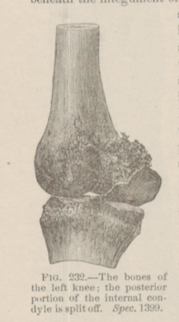Title: Kisner, S.
Source text: The Medical and Surgical History of the War of the Rebellion. (1861-65.), Part 3, Volume 2 (Washington, DC: Government Printing Office, 1883), 380.
Civil War Washington ID: med.d2e15643
TEI/XML: med.d2e15643.xml
CASE 569.—Private S. Kisner, Co. E, 7th Michigan,¹ aged 29 years, was wounded on picket near Chantilly, June 19, 1863, by a carbine shot, which entered the left thigh anteriorly at about its middle, passed downward and inward, and lodged beneath the integument on the inner side of the knee joint. He was brought to Washington and admitted to Stanton Hospital six days after being wounded. On June 27th, a conical ball was readily extracted through an incision, its situation being superficial. The joint at this time was neither swollen nor tender and did not appear to be involved in any way. On July 2d, some pain and swelling was noticed for the first time, when an ice-bag was applied to the knee. Two days later the swelling had extended up the thigh, and by July 6th there was well-marked erysipelas as well as effusion in the knee joint. Tincture of iodine was applied and tincture of muriate of iron was administered; stimulants were given freely. By July 8th, the erysipelas had extended clear up to the groin. On July 12th, the discharge of pus was free, and in consequence the tension and swelling of the thigh were sensibly diminished. The patient, however, was manifestly failing. On July 18th, he was seized with diarrhœa, and death supervened in the evening. The autopsy showed that the bullet had lacerated the sartorius muscle extensively and splintered the internal condyle of the femur. The joint and the cellular tissues of the thigh were filled with dark colored and very offensive pus, and the articular surfaces of the femur and tibia were denuded of cartilage. Surgeon J. A. Lidell, U. S. V., who furnished the history, with the pathological specimen (FIG. 232) and the missile (Specimen 3074, Surgical Section, A. M. M.), remarks: "The case interested me greatly, because when the bullet was extracted there was not the slightest evidence of injury to the inner condyle, nor indeed to any other bone whatever. The bullet was located quite superficially and not in relation with the injured condyle. During the eight days which elapsed between the receipt of the wound and the extraction of the missile said bullet must have slipped away from the bone into a new position. When, therefore, on July 2d, some inflammatory trouble in the knee appeared, we thought it was not due to an injury of the bone, but that the involvement of the joint originated from the soft parts. The case also affords a good illustration of the obscurity of the symptoms and the difficulty of diagnosis which may attend a serious gunshot injury of an articulation so thinly covered with soft parts and so easy of examination from every side as the knee joint."
¹ A brief abstract of this case was published in Circular No. 6, War Department, S. G. O., Washington, 1865, p. 36.
